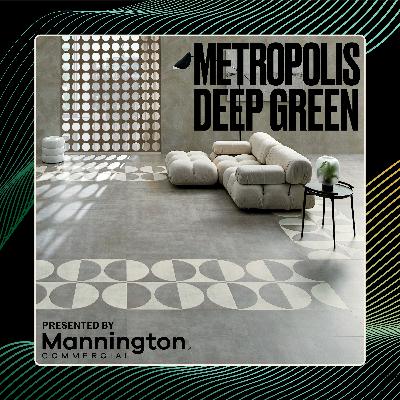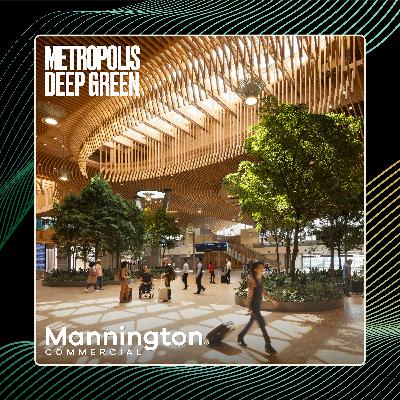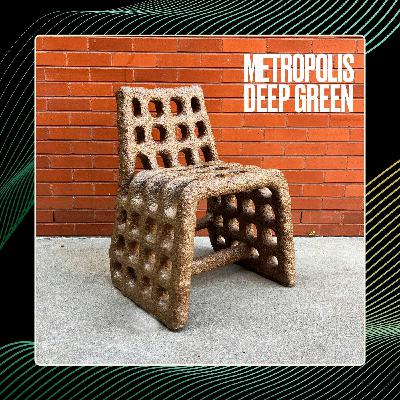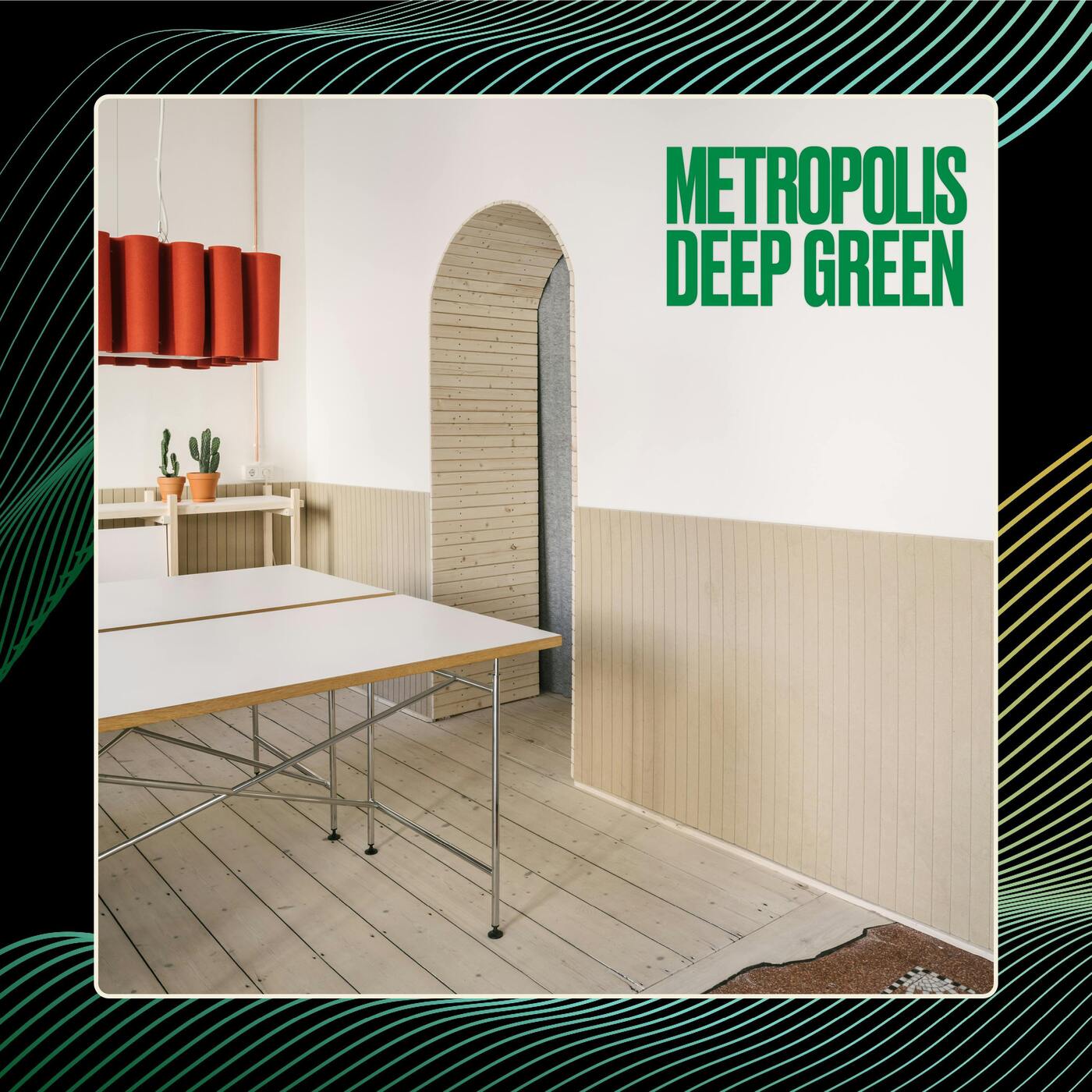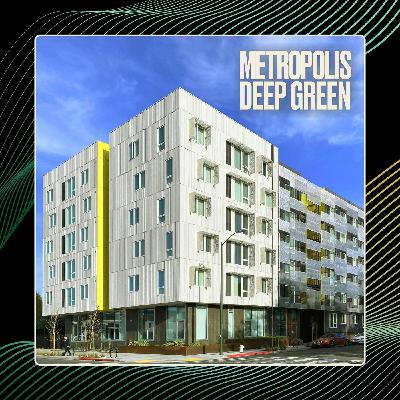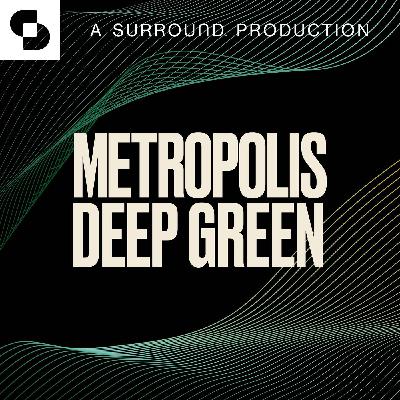Discover Deep Green
Deep Green

Deep Green
Author: Metropolis and SURROUND
Subscribed: 5Played: 102Subscribe
Share
© 2025 Metropolis
Description
Brought to you by Metropolis, Deep Green is a podcast about how the built environment impacts climate change and equity. Buildings are some of the biggest things we make as human beings. We explore how through understanding buildings, cities, and all the things that go into them, we can do better for the environment and all life on this planet.
47 Episodes
Reverse
Polyvinyl chloride—better known as PVC or vinyl—is one of the most ubiquitous plastics in our lives. You’ll find it everywhere: pipes, siding, wiring, flooring, upholstery, wall coverings, and even old-school vinyl records. Sixty-one percent of all PVC produced globally is used in buildings and construction. It’s more fire-retardant than any other common plastic, and with the addition of plasticizers, it can be made as flexible as fabric or as rigid as wood.In certain building types—like hospitals, hotels, and schools—PVC products are widely used because they’re durable, easy to maintain, and able to carry patterns and color. But many sustainability experts and design teams are urging the industry to reduce or avoid PVC where possible. When PVC isn’t responsibly manufactured or disposed of, it can expose workers and nearby communities to harmful dioxins. Poorly regulated PVC can also contain other chemicals of concern, such as heavy metals. For these reasons, the International Living Future Institute keeps PVC on its Red List of materials to avoid.So what’s the path forward? Should we focus on making PVC as safe and clean as possible—or invest in finding alternative materials that offer the same performance benefits?In this episode of Deep Green, created with our partner Mannington Commercial, host Avi Rajagopal sits down with three experts offering distinct perspectives: Shane Totten, vice president of sustainability at Mannington Commercial, which produces both certified, transparent PVC flooring and non-PVC resilient flooring options; David Briefel, sustainability director and principal at Gensler, and co-creator of the Gensler Product Sustainability Standards—a set of material requirements for the firm’s projects; and Annzie Barfield, interior design specialist at LaBella Associates, who works on education, healthcare, and senior living spaces where PVC products are often the default for flooring and wall protection.Together, they unpack the complexities—and possibilities—of designing with (or without) PVC.This season of Deep Green is produced in partnership with Mannington Commercial.Resources:“What Can We Do About PVC?” (METROPOLIS Nov/Dec Issue 2023)The Living Building Challenge (LBC) Red ListGensler Product Sustainability (GPS) StandardsMannington Mills TransparencySee Privacy Policy at https://art19.com/privacy and California Privacy Notice at https://art19.com/privacy#do-not-sell-my-info.
Buildings account for 40 percent of global carbon emissions. The construction industry generates nearly a third of all waste in our cities and built environments. The buildings we live and work in influence 11 of the 23 social determinants of health—factors that shape our well-being. And the construction sector is also the second most at risk for labor exploitation and modern-day slavery. We get a lot wrong when we make buildings, and we've spent the last three decades trying to fix that. But what if we shifted our focus—not just doing less bad, but doing more good? That’s the promise of regenerative design: the idea that buildings can help nature regenerate, not just minimize damage.In this episode of Deep Green, host Avi Rajagopal sits down with one of the pioneers of regenerative design, Jason McLennan, chief sustainability officer at Perkins&Will. McLennan is the mind behind transformative frameworks like the Living Building Challenge, the WELL Standard, and the Living Product Challenge, as well as the Declare, Just, and Net Zero certifications. His work has earned him prestigious honors including the Buckminster Fuller Prize, the ENR Award of Excellence, and an Ashoka Fellowship.If anyone can help us see the big picture of sustainability in architecture, it’s Jason McLennan. Tune in for a conversation about the future of buildings, design, and how we can create a world where architecture heals rather than harms.This season of Deep Green is produced in partnership with Mannington Commercial.ResourcesThe Living Building ChallengeThe International Living Future InstituteThe WELL Building StandardThe Living Product ChallengePerkins&Will SustainabilityDeclare Label ProgramSee Privacy Policy at https://art19.com/privacy and California Privacy Notice at https://art19.com/privacy#do-not-sell-my-info.
What makes one product more sustainable than another? It’s a question that anyone concerned with their impact on the planet must confront. How do we choose the right couch, coffee machine, flooring, tiles, or curtain wall system—so that we’re doing the most good for both people and the environment?That’s the question Lisa Gralnek has been working to answer.Gralnek is the U.S. Managing Director and Global Head of Sustainability and Impact at the iF Design Awards—one of the largest and most prestigious design award programs in the world. This year, 131 jurors evaluated nearly 11,000 entries from 66 countries, judging everything from appliances to automobiles, furnishings to buildings.For the first time, sustainability accounted for 20 percent of the score for every submission. So how does an international awards program assess sustainability across such diverse design disciplines, regions, and product categories?Listen to this episode of Deep Green, as METROPOLIS editor in chief Avi Rajagopal sits down with Gralnek to discuss how the iF Design Awards are tackling this challenge.This season of Deep Green is produced in partnership with Mannington Commercial.ResourcesiF DESIGN AWARDSSustainability and the iF DESIGN AWARDSiF Trend Report 2025See Privacy Policy at https://art19.com/privacy and California Privacy Notice at https://art19.com/privacy#do-not-sell-my-info.
If there’s one defining trend in American architecture over the last decade, it’s the rediscovery of wood as a construction material. Mass timber buildings—made from large wooden panels, columns, and beams—are rising across North America, with developers racing to construct the tallest wooden tower. A new contender, the 32-story Edison in Milwaukee, just broke ground and is set to claim the title of the tallest mass timber building in the Western Hemisphere.But why are American developers, architects, and builders all timberstruck? There are the carbon emissions—wood pulls down carbon dioxide from the atmosphere as trees grow, so these buildings are a tool in the fight against climate change. Plus, they are quick to construct and can be cheaper to build. So should we start building everything out of wood?In this episode of Deep Green, METROPOLIS editor in chief Avi Rajagopal speaks with two experts to unpack the potential of mass timber. First, Columbia University professor and author Lindsey Wikstrom discusses how architecture and construction need to evolve to fully embrace timber-based design. Then, DLR Group principal Stephen Cavanaugh shares insights from his extensive experience designing over three million square feet of mass timber buildings, as part of the largest collection of mass timber buildings in North America.Join us as we dive deep into the thinking behind and the practice of mass timber architecture.This season of Deep Green is produced in partnership with Mannington Commercial.Resources:Designing the Forest and other Mass Timber FuturesFinding a Future for Mass Timber in HospitalityDLR Group: Hines T3 PartnershipEpisode art: Photo by Creative Sources Photography/Rion Rizzo, courtesy DLR GroupSee Privacy Policy at https://art19.com/privacy and California Privacy Notice at https://art19.com/privacy#do-not-sell-my-info.
Buildings account for 40 percent of the world’s carbon emissions. If you’re an architect, or a frequent listener to this podcast, you already know that. But in their new book, Build Like It’s the End of the World, Sandeep Ahuja and Patrick Chopson frame buildings and carbon emissions in a way that might change how you think about it:“Buildings offer some of the most cost-efficient ways of reducing carbon emissions and combatting climate change. This is because, unlike carbon capture or more efficient cars, buildings have a lot of room for improvement in their design and construction, which is often not even simulated or cost optimized.”Ahuja and Chopson are the cofounders of Cove, an AI-powered consulting and technology platform that helps building designers and owners do just that—optimize buildings for both lower carbon emissions and lower costs. Every year, architects across the U.S. report their progress on reducing carbon emissions to the AIA, and Cove is the #1 tool they use to measure their impact. The goal? A 70 percent reduction in the building industry’s emissions by 2030.In this episode of Deep Green: Deep Cut, METROPOLIS editor in chief Avinash Rajagopal sits down with Ahuja and Chopson as they break down how Cove works, why they think we ignore cost and profit to our own peril, and how AI will be critical to the future of climate action.This season of Deep Green is produced in partnership with Mannington Commercial.Resources:coveBuild Like It’s the End of the WorldThree Technologies Are Changing how We Design for Climate See Privacy Policy at https://art19.com/privacy and California Privacy Notice at https://art19.com/privacy#do-not-sell-my-info.
Biophilic design might be trending on social media, but it’s far more than an aesthetic—it’s a transformative approach to creating spaces that make us happier, calmer, and healthier. In this episode of Deep Green: Deep Cut, METROPOLIS editor in chief Avinash Rajagopal dives into the science and philosophy behind biophilic design with Bill Browning, founder of Terrapin Bright Green, and Catie Ryan, director of projects at the firm. These leading voices in biophilic design share their insights on the profound impact of creating spaces that connect us to nature.As Terrapin Bright Green marks the 10th anniversary of its 14 Patterns of Biophilic Design, Browning and Ryan reflect on how their research has shaped the field, including the introduction of a new pattern: “Awe.” They share how these principles deliver measurable outcomes in projects like the reimagined Portland International Airport, where stress-filled spaces became calming, passenger-friendly environments under the terminal’s nine-acre roof. Tune in to learn how biophilic strategies—from nature-inspired fractals to immersive natural elements—are improving well-being, reducing stress, and redefining the built environment.This season of Deep Green is produced in partnership with Mannington Commercial.Resources:Moshe Safdie: The Future of Urban DensityWhat Is and Is Not Biophilic Design?14 Patterns of Biophilic DesignSee Privacy Policy at https://art19.com/privacy and California Privacy Notice at https://art19.com/privacy#do-not-sell-my-info.
In this bonus episode of Deep Green, host Avi Rajagopal reflects on the thought-provoking questions that have defined the show (Can bio-based plastics truly save the planet? Is recycling our hope for the future?) as he offers a glimpse into the exciting upcoming season, Deep Green: Deep Cut Edition.Listen and revisit standout moments from past episodes with some of the smartest people in design. And get ready for more fascinating discussions as Rajagopal sits down with sustainability visionaries and trailblazers to dive even deeper into how we can make buildings better for the planet—and for all of us—in the season ahead.This season of Deep Green is produced in partnership with Mannington Commercial.See Privacy Policy at https://art19.com/privacy and California Privacy Notice at https://art19.com/privacy#do-not-sell-my-info.
What is Office Furniture’s Role When it Comes to Climate Impact? In 2018, Americans threw out 12.1 million tons of furniture—and nearly 80 percent of that ended up in landfills. And the problem may not be where you think it is. Fast-furniture folks get a bad rap, right? It turns out that's not the biggest problem with furniture. Eight million or so of that 12.1 million tons of waste furniture was office furniture. There’s also growing research around the role of furniture in the impact of climate change on buildings. Over the life of a building, the renovations that happen—changing out the lights, furniture, carpet, etc.—on the inside of the building account for about half of the embodied carbon emissions of the building over its life. And out of that half, another half, so nearly 25 percent of the embodied carbon emissions in any building, is furniture. The good news? Research also shows that furniture might have the highest potential for us to lower the carbon emissions of interiors. In today’s episode, editor-in-chief of METROPOLIS Avi Rajagopal is going to talk to leaders in the furniture industry—KI (Jason Lazarz and Angela Allen), Allstee (Jason Hagadorn), and Steelcase (Katie Pace)—about their work responding to a changing society, a changing workplace market, but also increasing demands and a greater focus on furniture when it comes to climate impact. See Privacy Policy at https://art19.com/privacy and California Privacy Notice at https://art19.com/privacy#do-not-sell-my-info.
The furniture industry has seen something of a transformation over the last decade with the rise of fast furniture: cheap, disposable pieces, often produced overseas with little to no oversight. Every year in the United States, about 12 million tons of furniture goes to waste, and 80 percent of that ends up in our landfills. In addition to contributing, through that enormous amount of waste, to our environmental problems, furniture is also often cited as one of the industries most at risk for exploitative labor practices. But furniture retailer Room & Board was founded in 1980 as a business that’s different: putting sustainability at the heart of its operations since day one and producing 90 percent of its products in the United States. Most recently, the Minneapolis-based retailer achieved B Corp certification, an independent verification of its practices to show that it meets the highest standards of performance, accountability, and transparency on a range of factors from employee benefits to charitable giving, supply chain practices, and materials.In this episode, Room & Board director of sustainability Emily McGarvey joins METROPOLIS editor-in-chief Avinash Rajagopal to discuss why the retailer decided to aim for B Corp certification, how they went about it, and the challenges they faced—but also what it means at a very fundamental level for the furniture industry.This episode is brought to you in partnership with furniture retailer Room & Board. See Privacy Policy at https://art19.com/privacy and California Privacy Notice at https://art19.com/privacy#do-not-sell-my-info.
Discover industry tools and resources for circular design, as Avi Rajagopal and Samantha Sager discuss actionable steps we can take toward tackling the challenges discussed throughout this season of Deep Green. How can we make an impact on an individual level? How can we educate ourselves and those around us? What organizations can we turn to for guidance? Incredible tools, research, and innovations are helping the industry move in the right direction but to meet the moment we will have to shift away from our culture of consumption and redefine the roles of architects and designers in shaping a sustainable future. Hear from Rajagopal on his hopes for the journey forward. Chapters Review of the principles of circularity How can we pursue circularity as individuals? How can we pursue circularity as a community? Industry resources and tools Rethinking the designer’s role Resources Salvage Superstar: Renovation Angel Rheaply Brings Ingenuity to Recycling Building Materials Arup’s Circular Buildings Toolkit Two Platforms Help Designers Specify Low-Carbon Interiors Build Reuse Deep Green is produced by Samantha Sager, Wize Grazette, Lauren Volker, Rachel Senatore, and Hannah Viti, and is part of the SURROUND podcast network. Special thanks to Avi Rajagopal, Editor in Chief of METROPOLIS, for his insights. Recorded at the podcast studio by Vornado in the Penn 1 building in Manhattan. See Privacy Policy at https://art19.com/privacy and California Privacy Notice at https://art19.com/privacy#do-not-sell-my-info.
Learn how we can deepen the connection between the built environment and the natural world, as Avi Rajagopal and Samantha Sager discuss the third principle of circular design: regenerating nature. Navigating the complexities of where materials are derived from, how they are made, and what happens to them at the end of their useful life is crucial as architects and interior designers work to support a more circular economy. What defines a biobased product? How do we responsibly source these materials? Is a biobased plastic always biodegradable? Hear from Rajagopal on the ideas and experiments coming out of the industry designed to return more materials go back into their natural cycles and loops on this planet. Chapters The third principle of circularity: regenerating nature What does biobased actually mean? Biobased vs. Biodegradable Success story: a completely biodegradable chair Responsibly sourcing biobased materials Infrastructure and composting Resources PROWL Urges Designers to Consider the Afterlife of Products Model No. Furniture Natural Habitat: A Tranquil Retreat in Cold Spring Deep Green is produced by Samantha Sager, Wize Grazette, Lauren Volker, Rachel Senatore, and Hannah Viti, and is part of the SURROUND podcast network. Special thanks to Avi Rajagopal, Editor in Chief of METROPOLIS, for his insights. Recorded at the podcast studio by Vornado in the Penn 1 building in Manhattan. See Privacy Policy at https://art19.com/privacy and California Privacy Notice at https://art19.com/privacy#do-not-sell-my-info.
Explore the intricacies of material recycling, as Avi Rajagopal and Samantha Sager pick up where they left off last week, focusing on the second principle of a circular economy: circulating products and materials at their highest value. Are all materials suitable for recycling? How can we make sure that recycled or reused materials perform to the standards of commercial settings? How can we better design products and buildings for their end of life? Hear from Rajagopal on some innovative ways our industry is circulating products and materials, recycling more responsibly — and giving nature a much-needed break. Chapters Circulating products and materials at their highest value Recycling obstacles (incentive, policy, and more) Success story: Nylon The hierarchy of recycling strategies Designing for disassembly Resources METROPOLIS Climate Toolkit The Ellen MacArthur Foundation METROPOLIS July/August 2023: This New Upholstery Line Features Yarn Made From Marine Plastic Deep Green is produced by Samantha Sager, Wize Grazette, Lauren Volker, Rachel Senatore, and Hannah Viti, and is part of the SURROUND Podcast Network. Special thanks to Avi Rajagopal, Editor in Chief of METROPOLIS, for his insights. Recorded at the podcast studio by Vornado in the Penn 1 building in Manhattan.See Privacy Policy at https://art19.com/privacy and California Privacy Notice at https://art19.com/privacy#do-not-sell-my-info.
What obstacles does our industry present to the dream of a circular economy? Join METROPOLIS’s Editor in Chief, Avi Rajagopal, and producer Samantha Sager as they begin to explore these challenges, beginning with how we can eliminate more waste and pollution from our processes. A&D culture is shifting away from building new (for the first time in 2022, retrofits and renovations accounted for more money in architectural buildings than new construction!) but are we adapting buildings as sustainably as possible? Are we preparing them for future adaptations or just passing the buck? Are we considering the interiors? What about the communities that live around these projects? It’s easy to say, “Oh, let's reuse a building,” but in practice it tends to be a pretty tough and complicated process. Hear from Rajagopal on the steps our industry is taking to reuse more responsibly—and live a little bit closer to harmony with nature.ChaptersWhat are the principles of circularity?Principle 1: eliminating waste and pollutionUnpacking adaptive reuseFuture-proofing our buildingsResourcesMETROPOLIS Climate ToolkitThe Ellen MacArthur FoundationMETROPOLIS July/August: “3 Adaptive Reuse Projects Prioritize Flexibility for the Future”LMN’s Tenant Improvements Embodied Carbon StudyDeep Green is produced by Samantha Sager, Wize Grazette, Lauren Volker, and Rachel Senatore, and is part of the SURROUND Podcast Network. Special thanks to Avi Rajagopal, Editor in Chief of METROPOLIS, for his insights. Recorded at the podcast studio by Vornado in the Penn 1 building in Manhattan.See Privacy Policy at https://art19.com/privacy and California Privacy Notice at https://art19.com/privacy#do-not-sell-my-info.
Unpack the environmental impact of the building industry and the hurdles we face in reducing our carbon footprint with METROPOLIS’s' Editor in Chief, Avi Rajagopal, and producer Samantha Sager. They discuss how the sector is responsible for 40% of global carbon emissions and 30% of worldwide waste, and is the second largest consumer of plastics, putting the industry at the heart of the problem of the climate crisis. A must-listen for those passionate about sustainable interior design and architecture, this episode underscores the urgent need for change: a move away from our trend-driven culture. Join us this season as we explore the challenges our industry presents to the dream of a circular economy. May you be inspired to advocacy and action. ChaptersThe building industry and climate changeWhat is embodied carbon exactly?The consequences of a culture of trendsThe building renovations craze - and its implications ResourcesMETROPOLIS Climate Toolkit “Why Interior Designers Must Fight Climate Change”LMN’s Tenant Improvements Embodied Carbon StudyDeep Green is produced by Samantha Sager, Wize Grazette, Lauren Volker, and Rachel Senatore, and is part of the SURROUND Podcast Network. Special thanks to Avi Rajagopal, Editor in Chief of METROPOLIS, for his insights. Recorded at the podcast studio by Vornado in the Penn 1 building in Manhattan.See Privacy Policy at https://art19.com/privacy and California Privacy Notice at https://art19.com/privacy#do-not-sell-my-info.
Have you heard of the term biophilia or perhaps biophilic design? If you're an interior designer or you have a lot of interior design videos on your TikTok feed, you likely have. The word was popularized by a 1984 book by Edward O. Wilson, and he defined biophilia as the urge to affiliate with other forms of life. In recent years, designers have taken the word and interpreted it in many ways. Your wallpaper has a pattern that looks like wood grain, that's biophilic. Your glass and steel skyscraper has plants growing on its facade, that's biophilic.
In this episode, Metropolis contributor Audrey Gray talks to the renowned architect Moshe Safdie, who has spent his entire career navigating and exploring the relationship between buildings and nature. While he has been working on mega developments—like the legendary Habitat 67 project in Montreal and Marina Bay Sands Resort in Singapore—he has also been thinking about how nature is integrated into our cities. And that has led to an evolution of ideas about density and urban design. Join us to hear from Safdie about the release of his book, If Walls Could Speak: My Life in Architecture, and how he feels about the term biophilia and how it is being co-opted.
Connect with our host Avi Rajagopal on LinkedIn!
Discover more shows from SURROUND at surroundpodcasts.com. This episode of Barriers to Entry was produced and edited by Wize Grazette and Samantha Sager.
Learn more about your ad choices. Visit megaphone.fm/adchoices
See Privacy Policy at https://art19.com/privacy and California Privacy Notice at https://art19.com/privacy#do-not-sell-my-info.
On average, it costs about $2.95 per watt for a home solar system. So, a 6-kilowatt system, about the size you'd need for an American home, would set you back around $17,700. If you factor in solar incentives, like the Federal Solar Credit, that number can come down to about $12,400. The annual savings on your utility bills after installing a home solar system are about $1,346. So, over a 25- or 30-year period, those savings could be in the region of $30,000 or more. Not bad for a $12,400 investment. If of course you have $12,400 to invest.
As always, you’ve got to spend money to save money. And that means clean, affordable energy might stay out of reach of those who need it the most. Enter energy equity advocates like Daphany Rose Sanchez. Metropolis editor Jaxson Stone sat down with Sanchez, who is executive director at Kinetic Communities Consulting, which works with energy and affordable housing industry partners to connect, educate, and simplify energy efficiency opportunities for underrepresented communities. Join us to hear how Sanchez is working toward energy equity and learn more about the community solar movement and New York's Power Up initiative.
Connect with our guest Daphany Rose-Sanchez on LinkedIn!
Connect with our host Avi Rajagopal on LinkedIn!
Discover more shows from SURROUND at surroundpodcasts.com. This episode of Barriers to Entry was produced and edited by Wize Grazette and Samantha Sager.
Learn more about your ad choices. Visit megaphone.fm/adchoices
See Privacy Policy at https://art19.com/privacy and California Privacy Notice at https://art19.com/privacy#do-not-sell-my-info.
An estimated 100 million people globally don’t have a home. Experts say we need to be building 96,000 homes for them every day, or 3 billion people will end up without adequate housing by 2030. But 39 percent of the world’s carbon emissions come from the building industry, and people living in poverty are among the most vulnerable to the catastrophes caused by climate change. We need to build more homes to house the extremely poor who will then be the most affected by all the emissions created by building those homes. Unless we find a way to build affordable housing that’s also sustainable.
Metropolis deputy editor Kelly Beamon sat down with Katie Ackerly, a principal with David Baker Architects, who says the overlap between sustainability and affordability is almost 100 percent. Join us to learn more about how the San Francisco–based firm is building some of the toughest kinds of housing in one of the toughest housing markets in the U.S., and listen as Ackerly shares the ins and outs of sustainable housing design and what strategies she thinks could change the way we approach affordable housing at scale.
Connect with our guest Katie Ackerly on LinkedIn!
Connect with our host Avi Rajagopal on LinkedIn!
Discover more shows from SURROUND at surroundpodcasts.com. This episode of Barriers to Entry was produced and edited by Wize Grazette and Samantha Sager.
Learn more about your ad choices. Visit megaphone.fm/adchoices
See Privacy Policy at https://art19.com/privacy and California Privacy Notice at https://art19.com/privacy#do-not-sell-my-info.
Renowned architect and Chicagoan Carol Ross Barney joins host Avi Rajagopal for our Summer Season premier. Ross Barney is a visionary about how people live their lives in cities—whether it's through public, hospitality, or education spaces. Chicagoans know her best for the transformative work she did on the city’s Riverwalk, just steps away from where this episode was live recorded during NeoCon. Together, Rajagopal and Ross Barney discuss how the pedestrian walkway has opened so many possibilities for the city and how it is also emblematic of the kind of work that Ross Barney does. A sense of public good suffuses her work, from mammoth urban projects to her work on privately funded spaces, like the McDonald’s Chicago flagship. Join us to hear from Ross Barney about these landmark projects and others, exploring the connections between equity and the built environment, the complexities of sustainable design, and design as an opportunity to engage with people.
Connect with our guest Carol Ross Barney on LinkedIn!
Connect with our host Avi Rajagopal on LinkedIn!
Discover more shows from SURROUND at surroundpodcasts.com. This episode of Barriers to Entry was produced and edited by Wize Grazette and Samantha Sager.
Learn more about your ad choices. Visit megaphone.fm/adchoices
See Privacy Policy at https://art19.com/privacy and California Privacy Notice at https://art19.com/privacy#do-not-sell-my-info.
In this inspiring episode, host Avi Rajagopal is joined by Paola Antonelli, the senior curator of architecture and design at the Museum of Modern Art and the museum's first director of research and development. Together, they explore the transformative power of design in addressing critical global issues and the various projects Antonelli has been involved in, such as the 2019 Triennale di Milano exhibition “Broken Nature,” the MoMa salon series, and her collaboration with Alice Rawsthorn “Design Emergency.”
Through these many platforms, Antonelli hopes to create community, foster awareness, and catalyze change. In her discussion with Rajagopal, she emphasizes design’s role in society and power beyond mere decoration. They reflect on the pandemic and why it was such a watershed moment for the creative community, and look to the future with hope that we can design a better legacy.
Moments to check out:
Exploring the Impact of Design During the 2020 Pandemic (starts at 3:54)
Do you think of yourself as an optimist, even having accepted the reality of the end of our species? (starts at 24:45)
Connect with our host Avi Rajagopal on LinkedIn!
Discover more shows from SURROUND at surroundpodcasts.com. This episode of Barriers to Entry was produced and edited by SANDOW Design Group. Special thanks to the podcast production team: Wize Grazette, Hannah Viti, Samantha Sager and Rob Schulte.
Learn more about your ad choices. Visit megaphone.fm/adchoices
See Privacy Policy at https://art19.com/privacy and California Privacy Notice at https://art19.com/privacy#do-not-sell-my-info.
In this eye-opening episode, host Avi Rajagopal welcomes Sharon Prince, CEO and founder of Grace Farms, who discusses the pressing issue of modern-day slavery in the construction sector and her foundation's efforts to combat it through its Design for Freedom Initiative. Prince highlights the importance of ensuring fair labor conditions and the ethical sourcing of materials in all aspects of the built environment. The conversation delves into the Design for Freedom report, and the movement's ongoing work to raise awareness and drive institutional responses to create an ethically sourced and slave-free building material supply chain.
Prince and Rajagopal explore the necessity of inspecting and understanding the materials used in construction, furniture, textiles, and other elements of interior spaces, emphasizing that the next step in architectural justice must include social equity, and ethical material transparency. Listen to this critical discussion that calls for urgent action to address embodied suffering alongside embodied carbon in the green building movement in order to ensure a just and sustainable future.
Connect with Sharon Prince on LinkedIn!
Moments to check out:
List of twelve materials with evidence of force and child labor (starts at 5:22)
Prince shares her epiphany and the need for ethical material supply chain transparency (starts at 20:30)
Prince talks about the importance of conscious purchases (starts at 26:17)
Connect with our host Avi Rajagopal on LinkedIn!
Discover more shows from SURROUND at surroundpodcasts.com. This episode of Barriers to Entry was produced and edited by SANDOW Design Group. Special thanks to the podcast production team: Wize Grazette, Hannah Viti, Samantha Sager and Rob Schulte.
Learn more about your ad choices. Visit megaphone.fm/adchoices
See Privacy Policy at https://art19.com/privacy and California Privacy Notice at https://art19.com/privacy#do-not-sell-my-info.


